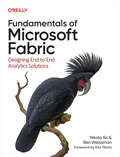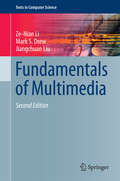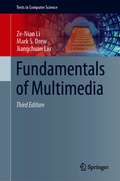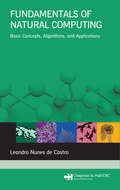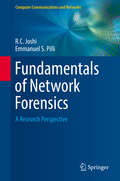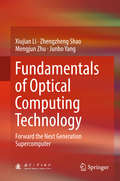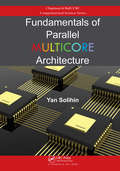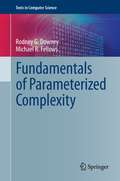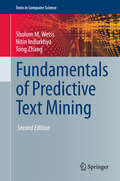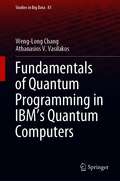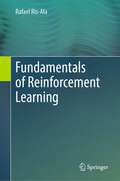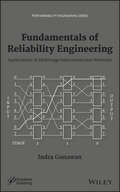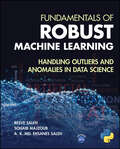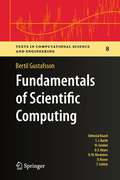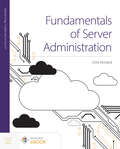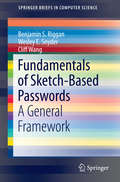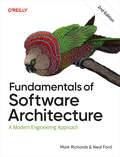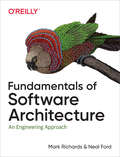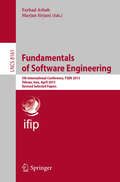- Table View
- List View
Fundamentals of Microsoft Fabric: Designing End-to-End Analytics Solutions
by Ben Weissman Nikola IlicIn the rapidly evolving world of data and analytics, professionals face the challenge of navigating complex platforms in order to build more efficient solutions. Microsoft Fabric, hailed as Microsoft’s “biggest data product in history after SQL Server,” offers powerful capabilities but comes with a steep learning curve. The myriad of choices within Fabric can be overwhelming, with multiple ways to tackle tasks, not all of which are equally efficient. This book serves as a definitive roadmap to understanding Microsoft Fabric—and leveraging it to suit your needs. Authors Nikola Ilic and Ben Weissman demystify the core concepts and components necessary to build, manage, and administer robust data solutions within this game-changing product. Discover the core Microsoft Fabric components and understand key concepts and techniques for building a robust data platform Learn to apply Microsoft Fabric effectively in your day-to-day job Understand the concept of a lake-centric architecture Gain the skills to implement a scalable and efficient end-to-end analytics solution Manage and administer a Fabric tenant
Fundamentals of Modern Electric Circuit Analysis and Filter Synthesis: A Transfer Function Approach
by Afshin IzadianThis textbook explains the fundamentals of electric circuits and uses the transfer function as a tool to analyze circuits, systems, and filters. The author avoids the Fourier transform and three phase circuits, since these topics are often not taught in circuits courses. General transfer functions for low pass, high pass, band pass and band reject filters are demonstrated, with first order and higher order filters explained in plain language. The author’s presentation is designed to be accessible to a broad audience, with the concepts of circuit analysis explained in basic language, reinforced by numerous, solved examples.
Fundamentals of Modern Electric Circuit Analysis and Filter Synthesis: A Transfer Function Approach
by Afshin IzadianThis textbook explains the fundamentals of electric circuits and uses the transfer function as a tool to analyze circuits, systems, and filters. The author avoids the Fourier transform, since this topic is often not taught in circuits courses. General transfer functions for low pass, high pass, band pass and band reject filters are demonstrated, with first order and higher order filters explained in plain language. The author’s presentation is designed to be accessible to a broad audience, with the concepts of circuit analysis explained in basic language, reinforced by numerous, solved examples.
Fundamentals of Multicore Software Development (Chapman & Hall/CRC Computational Science)
by Victor Pankratius Ali-Reza Adl-Tabatabai Walter TichyWith multicore processors now in every computer, server, and embedded device, the need for cost-effective, reliable parallel software has never been greater. By explaining key aspects of multicore programming, Fundamentals of Multicore Software Development helps software engineers understand parallel programming and master the multicore challenge.
Fundamentals of Multimedia
by Jiangchuan Liu Ze-Nian Li Mark S. DrewThis textbook introduces the "Fundamentals of Multimedia", addressing real issues commonly faced in the workplace. The essential concepts are explained in a practical way to enable students to apply their existing skills to address problems in multimedia. Fully revised and updated, this new edition now includes coverage of such topics as 3D TV, social networks, high-efficiency video compression and conferencing, wireless and mobile networks, and their attendant technologies. Features: presents an overview of the key concepts in multimedia, including color science; reviews lossless and lossy compression methods for image, video and audio data; examines the demands placed by multimedia communications on wired and wireless networks; discusses the impact of social media and cloud computing on information sharing and on multimedia content search and retrieval; includes study exercises at the end of each chapter; provides supplementary resources for both students and instructors at an associated website.
Fundamentals of Multimedia (Texts in Computer Science)
by Jiangchuan Liu Ze-Nian Li Mark S. DrewPREVIOUS EDITIONThis textbook introduces the “Fundamentals of Multimedia”, addressing real issues commonly faced in the workplace. The essential concepts are explained in a practical way to enable students to apply their existing skills to address problems in multimedia. Fully revised and updated, this new edition now includes coverage of such topics as 3D TV, social networks, high-efficiency video compression and conferencing, wireless and mobile networks, and their attendant technologies. Features: presents an overview of the key concepts in multimedia, including color science; reviews lossless and lossy compression methods for image, video and audio data; examines the demands placed by multimedia communications on wired and wireless networks; discusses the impact of social media and cloud computing on information sharing and on multimedia content search and retrieval; includes study exercises at the end of each chapter; provides supplementary resources for both students and instructors at an associated website.
Fundamentals of Natural Computing: Basic Concepts, Algorithms, and Applications (Chapman & Hall/CRC Computer and Information Science Series)
by Leandro Nunes de CastroNatural computing brings together nature and computing to develop new computational tools for problem solving; to synthesize natural patterns and behaviors in computers; and to potentially design novel types of computers. Fundamentals of Natural Computing: Basic Concepts, Algorithms, and Applications presents a wide-ranging survey of novel techniqu
Fundamentals of Network Forensics: A Research Perspective (Computer Communications and Networks)
by Emmanuel S. Pilli R.C. JoshiThis timely text/reference presents a detailed introduction to the essential aspects of computer network forensics. The book considers not only how to uncover information hidden in email messages, web pages and web servers, but also what this reveals about the functioning of the Internet and its core protocols. This, in turn, enables the identification of shortcomings and highlights where improvements can be made for a more secure network. Topics and features: provides learning objectives in every chapter, and review questions throughout the book to test understanding; introduces the basic concepts of network process models, network forensics frameworks and network forensics tools; discusses various techniques for the acquisition of packets in a network forensics system, network forensics analysis, and attribution in network forensics; examines a range of advanced topics, including botnet, smartphone, and cloud forensics; reviews a number of freely available tools for performing forensic activities.
Fundamentals of Optical Computing Technology: Forward The Next Generation Supercomputer
by Xiujian Li Zhengzheng Shao Mengjun Zhu Junbo YangThis book presents the principles, experimental technologies, up-to-date research findings and applications of various optical-computing technologies and devices. It also discusses semiconductor multiple quantum well (MQW) photoelectronic devices, vertical-cavity surface-emitting lasers (VCSELs), lasers, micro optical elements and diffractive optical elements, optical storage, optical parallel interconnections, and optical-buffer technology as the main technologies for optical computing. Furthermore, it explores the potential of optical-computing technology. It offers those involved in optical design, photonics, and photoelectronic research and related industries insights into the fundamentals and theories of optical computing, enabling them and to extend and develop the functions of fundamental elements to meet the requirement of optical-computing systems.
Fundamentals of Optical Networks and Components
by Partha Pratim SahuThis book is intended as an undergraduate/postgraduate level textbook for courses on high-speed optical networks as well as computer networks. Nine chapters cover the basic principles of the technology and different devices for optical networks, as well as processing of integrated waveguide devices of optical networks using different technologies. It provides students, researchers and practicing engineers with an expert guide to the fundamental concepts, issues and state-of-the-art developments in optical networks. It includes examples throughout all the chapters of the book to aid understanding of basic problems and solutions. Presents basics of the optical network devices and discusses latest developments Includes examples and exercises throughout all the chapters of the book to aid understanding of basic problems and solutions for undergraduate and postgraduate students Discusses different optical network node architectures and their components Includes basic theories and latest developments of hardware devices with their fabrication technologies (such as optical switch, wavelength router, wavelength division multiplexer/demultiplexer and add/drop multiplexer), helpful for researchers to initiate research on this field and to develop research problem-solving capability Reviews fiber-optic networks without WDM and single-hop and multi-hop WDM optical networks P. P. Sahu received his M.Tech. degree from the Indian Institute of Technology Delhi and his Ph.D. degree in engineering from Jadavpur University, India. In 1991, he joined Haryana State Electronics Development Corporation Limited, where he has been engaged in R&D works related to optical fiber components and telecommunication instruments. In 1996, he joined Northeastern Regional Institute of Science and Technology as a faculty member. At present, he is working as a professor in the Department of Electronics and Communication Engineering, Tezpur Central University, India. His field of interest is integrated optic and electronic circuits, wireless and optical communication, clinical instrumentation, green energy, etc. He has received an INSA teacher award (instituted by the highest academic body Indian National Science Academy) for high level of teaching and research. He has published more than 90 papers in peer-reviewed international journals, 60 papers in international conference, and has written five books published by Springer Nature, McGraw-Hill. Dr Sahu is a Fellow of the Optical Society of India, Life Member of Indian Society for Technical Education and Senior Member of the IEEE.
Fundamentals of Parallel Multicore Architecture: Multichip And Multicore Systems (Chapman And Hall/crc Computational Science Ser.)
by Yan SolihinAlthough multicore is now a mainstream architecture, there are few textbooks that cover parallel multicore architectures. Filling this gap, Fundamentals of Parallel Multicore Architecture provides all the material for a graduate or senior undergraduate course that focuses on the architecture of multicore processors. The book is also useful as a ref
Fundamentals of Parameterized Complexity
by Rodney G. Downey Michael R. FellowsThis comprehensive and self-contained textbook presents an accessible overview of the state of the art of multivariate algorithmics and complexity. Increasingly, multivariate algorithmics is having significant practical impact in many application domains, with even more developments on the horizon. The text describes how the multivariate framework allows an extended dialog with a problem, enabling the reader who masters the complexity issues under discussion to use the positive and negative toolkits in their own research. Features: describes many of the standard algorithmic techniques available for establishing parametric tractability; reviews the classical hardness classes; explores the various limitations and relaxations of the methods; showcases the powerful new lower bound techniques; examines various different algorithmic solutions to the same problems, highlighting the insights to be gained from each approach; demonstrates how complexity methods and ideas have evolved over the past 25 years.
Fundamentals of Predictive Text Mining
by Sholom M. Weiss Nitin Indurkhya Tong ZhangOne consequence of the pervasive use of computers is that most documents originate in digital form. Widespread use of the Internet makes them readily available. Text mining - the process of analyzing unstructured natural-language text - is concerned with how to extract information from these documents. Developed from the authors' highly successful Springer reference on text mining, Fundamentals of Predictive Text Mining is an introductory textbook and guide to this rapidly evolving field. Integrating topics spanning the varied disciplines of data mining, machine learning, databases, and computational linguistics, this uniquely useful book also provides practical advice for text mining. In-depth discussions are presented on issues of document classification, information retrieval, clustering and organizing documents, information extraction, web-based data-sourcing, and prediction and evaluation. Background on data mining is beneficial, but not essential. Where advanced concepts are discussed that require mathematical maturity for a proper understanding, intuitive explanations are also provided for less advanced readers. Topics and features: presents a comprehensive, practical and easy-to-read introduction to text mining; includes chapter summaries, useful historical and bibliographic remarks, and classroom-tested exercises for each chapter; explores the application and utility of each method, as well as the optimum techniques for specific scenarios; provides several descriptive case studies that take readers from problem description to systems deployment in the real world; includes access to industrial-strength text-mining software that runs on any computer; describes methods that rely on basic statistical techniques, thus allowing for relevance to all languages (not just English); contains links to free downloadable software and other supplementary instruction material. Fundamentals of Predictive Text Mining is an essential resource for IT professionals and managers, as well as a key text for advanced undergraduate computer science students and beginning graduate students. Dr. Sholom M. Weiss is a Research Staff Member with the IBM Predictive Modeling group, in Yorktown Heights, New York, and Professor Emeritus of Computer Science at Rutgers University. Dr. Nitin Indurkhya is Professor at the School of Computer Science and Engineering, University of New South Wales, Australia, as well as founder and president of data-mining consulting company Data-Miner Pty Ltd. Dr. Tong Zhang is Associate Professor at the Department of Statistics and Biostatistics at Rutgers University, New Jersey.
Fundamentals of Quantum Computing: Theory and Practice
by Venkateswaran KasirajanThis introductory book on quantum computing includes an emphasis on the development of algorithms. Appropriate for both university students as well as software developers interested in programming a quantum computer, this practical approach to modern quantum computing takes the reader through the required background and up to the latest developments. Beginning with introductory chapters on the required math and quantum mechanics, Fundamentals of Quantum Computing proceeds to describe four leading qubit modalities and explains the core principles of quantum computing in detail. Providing a step-by-step derivation of math and source code, some of the well-known quantum algorithms are explained in simple ways so the reader can try them either on IBM Q or Microsoft QDK. The book also includes a chapter on adiabatic quantum computing and modern concepts such as topological quantum computing and surface codes.Features:o Foundational chapters that build the necessary background on math and quantum mechanics.o Examples and illustrations throughout provide a practical approach to quantum programming with end-of-chapter exercises.o Detailed treatment on four leading qubit modalities -- trapped-ion, superconducting transmons, topological qubits, and quantum dots -- teaches how qubits work so that readers can understand how quantum computers work under the hood and devise efficient algorithms and error correction codes. Also introduces protected qubits - 0-π qubits, fluxon parity protected qubits, and charge-parity protected qubits. o Principles of quantum computing, such as quantum superposition principle, quantum entanglement, quantum teleportation, no-cloning theorem, quantum parallelism, and quantum interference are explained in detail. A dedicated chapter on quantum algorithm explores both oracle-based, and Quantum Fourier Transform-based algorithms in detail with step-by-step math and working code that runs on IBM QisKit and Microsoft QDK. Topics on EPR Paradox, Quantum Key Distribution protocols, Density Matrix formalism, and Stabilizer formalism are intriguing. While focusing on the universal gate model of quantum computing, this book also introduces adiabatic quantum computing and quantum annealing.This book includes a section on fault-tolerant quantum computing to make the discussions complete. The topics on Quantum Error Correction, Surface codes such as Toric code and Planar code, and protected qubits help explain how fault tolerance can be built at the system level.
Fundamentals of Quantum Programming in IBM's Quantum Computers (Studies in Big Data #81)
by Athanasios V. Vasilakos Weng-Long ChangThis textbook introduces major topics that include quantum bits, superposition, entanglement, logic gates, quantum search algorithm, quantum Fourier transform, inverse quantum Fourier transform, Shor’s order-finding algorithm and phase estimation. Everyone can write algorithms and programs in the cloud making using IBM’s quantum computers that support IBM Q Experience which contains the composer, open quantum assembly language, simulators and real quantum devices. Furthermore, this book teaches you how to use open quantum assembly language to write quantum programs for dealing with complex problems. Through numerous examples and exercises, readers will learn how to write a quantum program with open quantum assembly language for solving any problem from start to complete. This book includes six main chapters: ·Quantum Bits and Quantum Gates—learn what quantum bits are, how to declare and measure them, what quantum gates are and how they work on a simulator or a real device in the cloud. ·Boolean Algebra and its Applications—learn how to decompose CCNOT gate into six CNOT gates and nine gates of one bit and how to use NOT gates, CNOT gates and CCNOT gates to implement logic operations including NOT, OR, AND, NOR, NAND, Exclusive-OR (XOR) and Exclusive-NOR (XNOR). ·Quantum Search Algorithm and its Applications—learn core concepts of quantum search algorithm and how to write quantum programs to implement core concepts of quantum search algorithm for solving two famous NP-complete problems that are the satisfiability problem in n Boolean variables and m clauses and the clique problem in a graph with n vertices and q edges. ·Quantum Fourier Transform and its Applications—learn core concepts of quantum Fourier transform and inverse quantum Fourier transform and how to write quantum programs to implement them for solving two real applications that are to compute the period and the frequency of two given oracular functions. ·Order-Finding and Factoring—learn core concepts of Shor’s order-finding algorithm and how to write quantum programs to implement Shor’s order-finding algorithm for completing the prime factorization to 15. Phase Estimation and its Applications—learn core concepts of phase estimation and quantum counting and how to write quantum programs to implement them to compute the number of solution(s) in the independent set problem in a graph with two vertices and one edge.
Fundamentals of Reinforcement Learning
by Rafael Ris-AlaArtificial intelligence (AI) applications bring agility and modernity to our lives, and the reinforcement learning technique is at the forefront of this technology. It can outperform human competitors in strategy games, creative compositing, and autonomous movement. Moreover, it is just starting to transform our civilization.This book provides an introduction to AI, specifies machine learning techniques, and explores various aspects of reinforcement learning, approaching the latest concepts in a didactic and illustrated manner. It is aimed at students who want to be part of technological advances and professors engaged in the development of innovative applications, helping with academic and industrial challenges.Understanding the Fundamentals of Reinforcement Learning will allow you to:Understand essential AI conceptsGain professional experienceInterpret sequential decision problems and solve them with reinforcement learningLearn how the Q-Learning algorithm worksPractice with commented Python codeFind advantageous directions
Fundamentals of Reliability Engineering: Applications in Multistage Interconnection Networks
by Indra GunawanThis book presents fundamentals of reliability engineering with its applications in evaluating reliability of multistage interconnection networks. In the first part of the book, it introduces the concept of reliability engineering, elements of probability theory, probability distributions, availability and data analysis. The second part of the book provides an overview of parallel/distributed computing, network design considerations, and more. The book covers a comprehensive reliability engineering methods and its practical aspects in the interconnection network systems. Students, engineers, researchers, managers will find this book as a valuable reference source.
Fundamentals of Robust Machine Learning: Handling Outliers and Anomalies in Data Science
by A. K. Saleh Resve A. Saleh Sohaib MajzoubAn essential guide for tackling outliers and anomalies in machine learning and data science. In recent years, machine learning (ML) has transformed virtually every area of research and technology, becoming one of the key tools for data scientists. Robust machine learning is a new approach to handling outliers in datasets, which is an often-overlooked aspect of data science. Ignoring outliers can lead to bad business decisions, wrong medical diagnoses, reaching the wrong conclusions or incorrectly assessing feature importance, just to name a few. Fundamentals of Robust Machine Learning offers a thorough but accessible overview of this subject by focusing on how to properly handle outliers and anomalies in datasets. There are two main approaches described in the book: using outlier-tolerant ML tools, or removing outliers before using conventional tools. Balancing theoretical foundations with practical Python code, it provides all the necessary skills to enhance the accuracy, stability and reliability of ML models. Fundamentals of Robust Machine Learning readers will also find: A blend of robust statistics and machine learning principlesDetailed discussion of a wide range of robust machine learning methodologies, from robust clustering, regression and classification, to neural networks and anomaly detectionPython code with immediate application to data science problems Fundamentals of Robust Machine Learning is ideal for undergraduate or graduate students in data science, machine learning, and related fields, as well as for professionals in the field looking to enhance their understanding of building models in the presence of outliers.
Fundamentals of Scientific Computing
by Bertil GustafssonThe book of nature is written in the language of mathematics -- Galileo Galilei How is it possible to predict weather patterns for tomorrow, with access solely to today's weather data? And how is it possible to predict the aerodynamic behavior of an aircraft that has yet to be built? The answer is computer simulations based on mathematical models - sets of equations - that describe the underlying physical properties. However, these equations are usually much too complicated to solve, either by the smartest mathematician or the largest supercomputer. This problem is overcome by constructing an approximation: a numerical model with a simpler structure can be translated into a program that tells the computer how to carry out the simulation. This book conveys the fundamentals of mathematical models, numerical methods and algorithms. Opening with a tutorial on mathematical models and analysis, it proceeds to introduce the most important classes of numerical methods, with finite element, finite difference and spectral methods as central tools. The concluding section describes applications in physics and engineering, including wave propagation, heat conduction and fluid dynamics. Also covered are the principles of computers and programming, including MATLAB®.
Fundamentals of Server Administration
by Chris KinnairdFundamentals of Server Administration equips students and professionals with the essential skills to manage both on-premise and cloud-based server environments, addressing the growing knowledge gap as organizations adopt platforms like Amazon AWS and Microsoft Azure while continuing to deploy and manage critical infrastructure on local servers. This comprehensive resource covers key topics and concepts for Windows and Linux server environments and includes graphical and console-based administration activities. It provides practical knowledge and supports industry-recognized credentials needed to succeed in today’s evolving IT landscape, aligning with the CompTIA Server+ (SK0-005) certification and the CompTIA Network Infrastructure Professional stackable certification for students who also obtain the Network+ certification.
Fundamentals of Sketch-Based Passwords
by Cliff Wang Benjamin S. Riggan Wesley E. SnyderThis SpringerBrief explores graphical password systems and examines novel drawing-based methods in terms of security, usability, and human computer-interactions. It provides a systematic approach for recognizing, comparing, and matching sketch-based passwords in the context of modern computing systems. The book offers both a security and usability analysis of the accumulative framework used for incorporating handwriting biometrics and a human computer-interaction performance analysis. The chapters offer new perspectives and experimental results regarding model uniqueness, recognition tolerance, and the human-computer interaction. The results demonstrate that biometrics reduce the equal error rate (EER) by more than 10%, and show that people are capable of accurately reproducing a sketch-based password. Fundamentals of Sketch-based Passwords: A General Framework targets computer scientists and engineers focused on computer security, biometrics, and human factors. Advanced-level students in computer science and electrical engineering will find this material useful as a study guide for their classes.
Fundamentals of Software Architecture
by Neal Ford Mark RichardsSalary surveys worldwide regularly place software architect in the top 10 best jobs, yet no real guide exists to help developers become architects. Until now. This updated edition provides a comprehensive overview of software architecture's many aspects, with five new chapters covering the latest insights from the field. Aspiring and existing architects alike will examine architectural characteristics, architectural patterns, component determination, diagramming architecture, governance, data, generative AI, team topologies, and many other topics. Mark Richards and Neal Ford—hands-on practitioners who have taught software architecture classes professionally for years—focus on architecture principles that apply across all technology stacks. You'll explore software architecture in a modern light, taking into account all the innovations of the past decade. This book examines:Architecture styles and patterns: Microservices, modular monoliths, microkernels, layered architectures, and many moreComponents: Identification, coupling, cohesion, partitioning, and granularitySoft skills: Effective team management, collaboration, business engagement models, negotiation, presentations, and moreModernity: Engineering practices and operational approaches that have changed radically in the past few years, including cloud considerations and generative AIArchitecture as an engineering discipline: Repeatable results, metrics, and concrete valuations that add rigor to software architecture
Fundamentals of Software Architecture: An Engineering Approach
by Neal Ford Mark RichardsSalary surveys worldwide regularly place software architect in the top 10 best jobs, yet no real guide exists to help developers become architects. Until now. This book provides the first comprehensive overview of software architecture’s many aspects. Aspiring and existing architects alike will examine architectural characteristics, architectural patterns, component determination, diagramming and presenting architecture, evolutionary architecture, and many other topics.Mark Richards and Neal Ford—hands-on practitioners who have taught software architecture classes professionally for years—focus on architecture principles that apply across all technology stacks. You’ll explore software architecture in a modern light, taking into account all the innovations of the past decade.This book examines:Architecture patterns: The technical basis for many architectural decisionsComponents: Identification, coupling, cohesion, partitioning, and granularitySoft skills: Effective team management, meetings, negotiation, presentations, and moreModernity: Engineering practices and operational approaches that have changed radically in the past few yearsArchitecture as an engineering discipline: Repeatable results, metrics, and concrete valuations that add rigor to software architecture
Fundamentals of Software Culture
by Zheng Qin Huidi Zhang Xin Qin Kaiping Xu Kouemo Ngayo Dimitrov Guolong Wang Wenhui YuAs the first book about software culture, this book discusses software culture from three perspectives including historical perspective, the classification of software and software applications. This book takes credit from the view of science and technology development. It analyzed scientific innovations and the social areas promoted following the growth of technology. And according to the fact that information helps to build human cultural form, we proposed the concept and researching method of software culture. The aim of writing this book is to strengthen the connection between software and culture, to replenish knowledge system in the subject of software engineering, and to establish a new area of study that is the culture of software.
Fundamentals of Software Engineering
by Farhad Arbab Marjan SirjaniThis book constitutes the proceedings of the 5th IPM International Conference on Fundamentals of Software Engineering, FSEN 2013, held in Tehran, Iran, in April 2013. The 17 full papers presented in this volume were carefully reviewed and selected from 65 submissions. The topics of interest in FSEN span over all aspects of formal methods, especially those related to advancing the application of formal methods in software industry and promoting their integration with practical engineering techniques.
